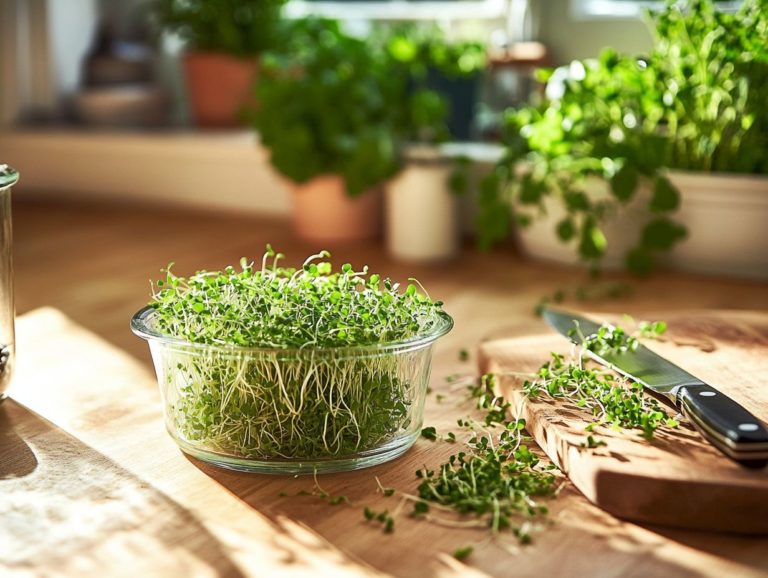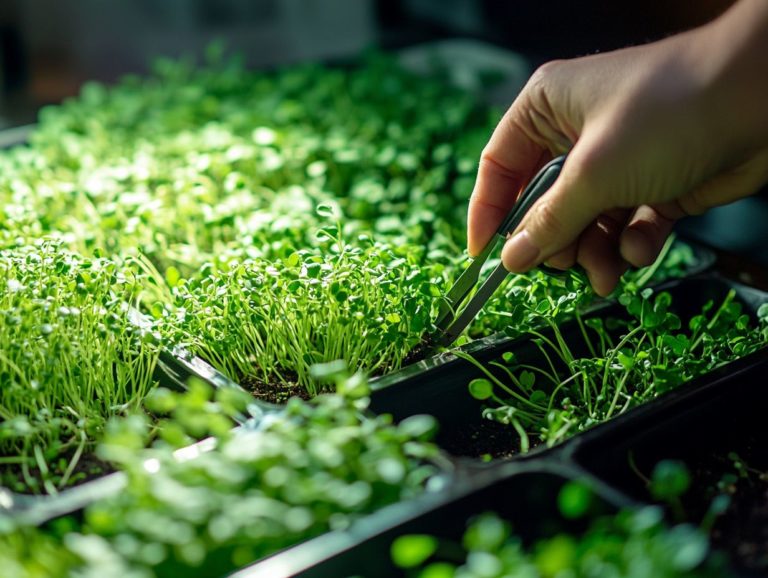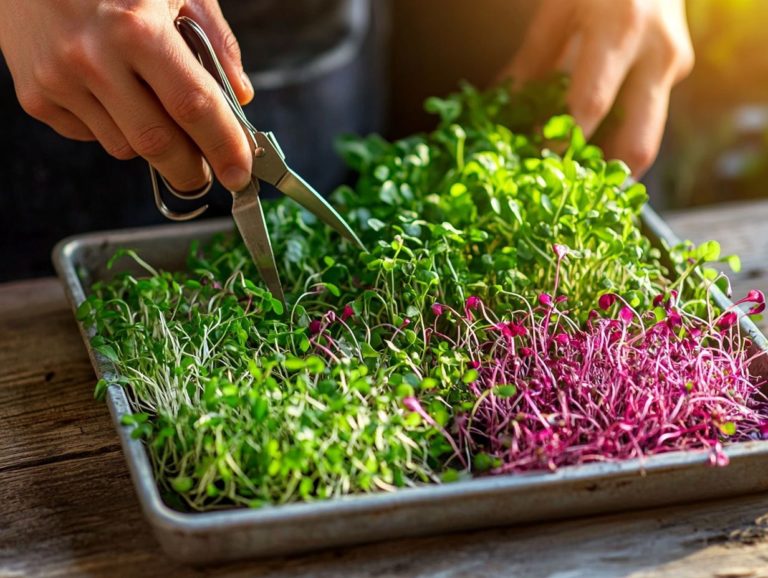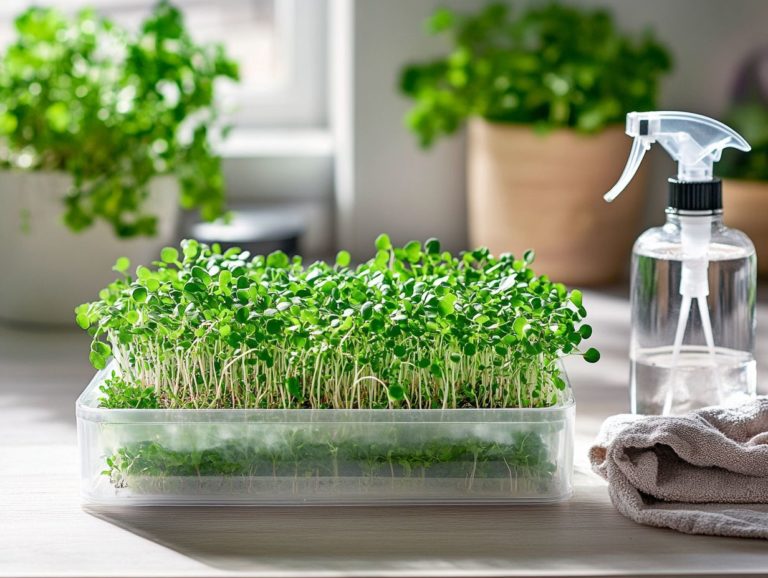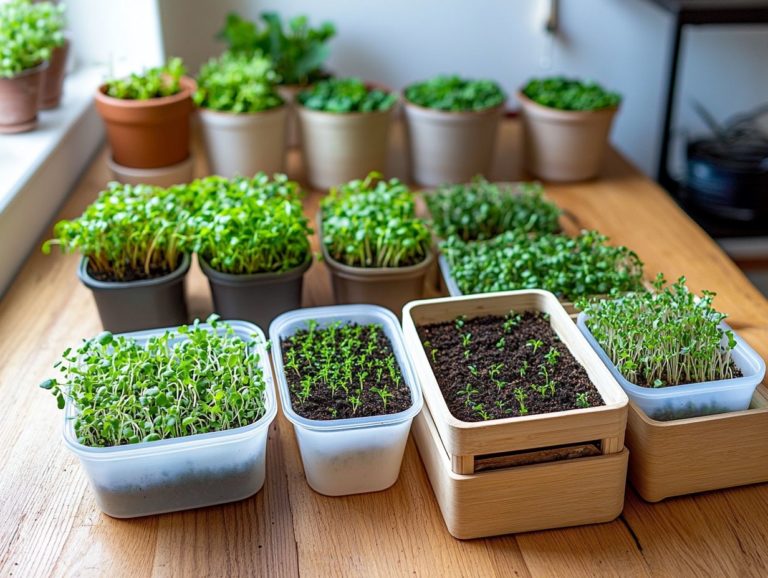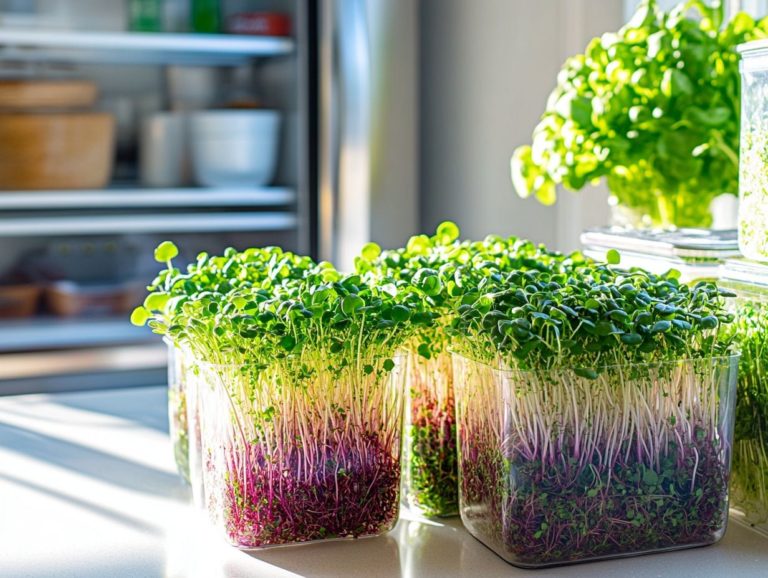Harvesting Microgreens: The Right Timing
Microgreens are not just tiny plants; they’re nutrient-rich plants that infuse your dishes with vibrant flavors and stunning colors. Cultivating them at home elevates your culinary artistry and enriches your meals with remarkable health benefits.
This article delves into the best practices for growing and harvesting microgreens. It highlights their nutritional value, ideal harvesting times, and the essential steps to maximize your yield. It also covers common mistakes to avoid, ensuring you can enjoy fresh microgreens year-round.
Contents
- Key Takeaways:
- Benefits of Growing and Harvesting Microgreens
- When to Harvest Microgreens
- How to Harvest Microgreens
- Storage and Preservation of Microgreens
- Common Mistakes in Harvesting Microgreens
- Frequently Asked Questions
- When is the right time to harvest microgreens?
- When is the right time to harvest microgreens?
- How do I determine if my microgreens are ready to be harvested?
- What happens if I wait too long to harvest my microgreens?
- Can I harvest my microgreens more than once?
- Should I harvest my microgreens in the morning or evening?
- What is the best way to harvest microgreens?
Key Takeaways:
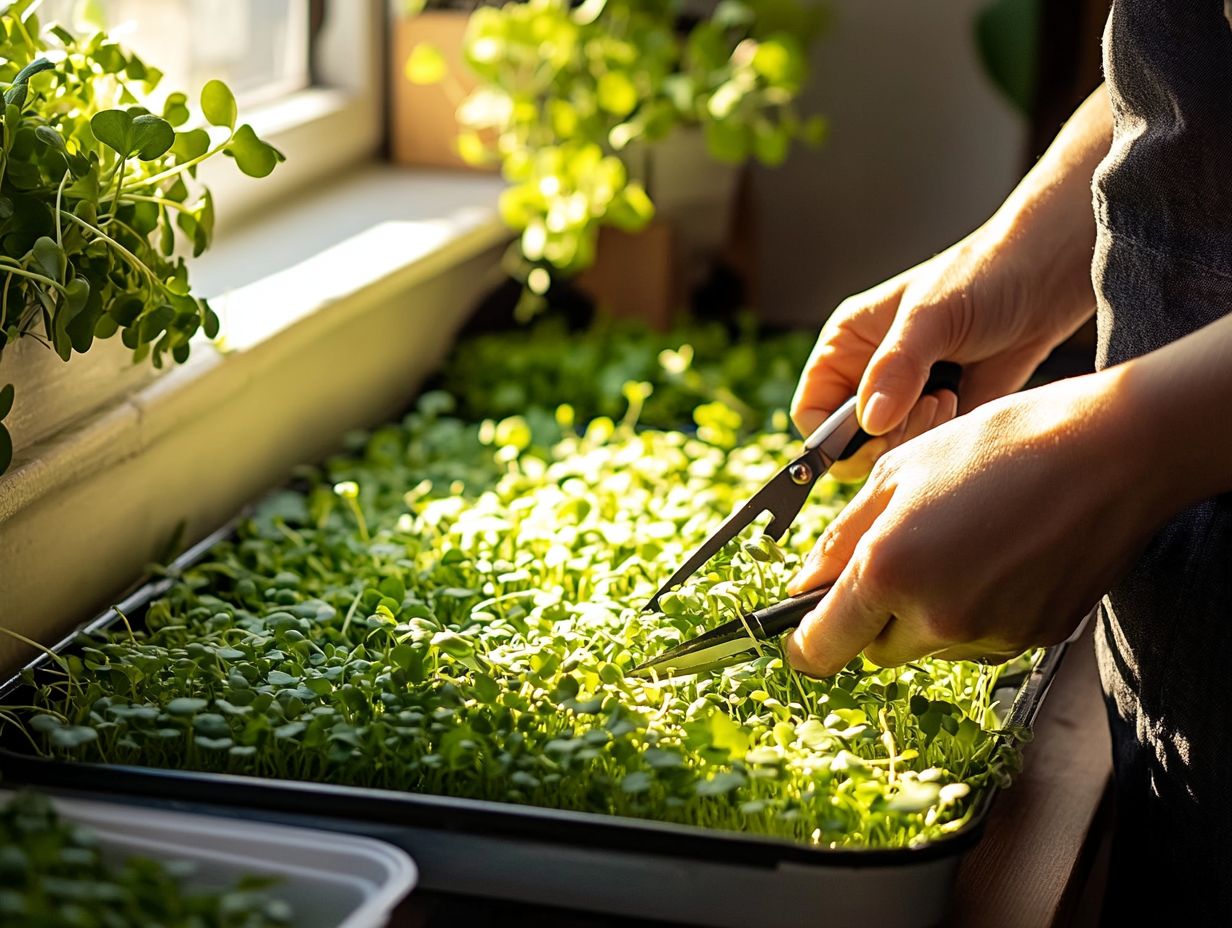
- Harvest your microgreens at just the right moment for the best flavor and nutrition.
- Factors such as the type of microgreen, growing conditions, and desired maturity level can affect harvesting time.
- Proper harvesting techniques and storage practices are essential for maintaining freshness and avoiding common mistakes.
What are Microgreens?
Microgreens are young plants that you ll want to embrace. They are often harvested right after their first true leaves, known as cotyledons, have appeared.
These vibrant little greens come from various species, including herbs and vegetables, presenting an array of colors and distinct flavors. They pack a nutritional punch that makes them a favorite in indoor gardening and urban farming.
Not only do microgreens enhance the presentation of your dishes, but they also boost the flavor and nutritional value of your meals, offering a refreshing twist that can transform any recipe.
Among the exciting types of microgreens you can explore are arugula, radish, basil, and cilantro. Each brings its unique taste and texture to your culinary creations.
The growth journey begins with seed germination and progresses through seedling development until those first true leaves appear, marking the optimal harvest time usually within a brisk 7 to 21 days.
In the kitchen, these greens truly shine, whether tossed into salads, layered in sandwiches, or used as vibrant garnishes. They add a delightful burst of flavor and color.
Beyond their culinary charm, microgreens hold a significant place in urban farming. They enable city dwellers to grow fresh produce in limited spaces, promoting sustainability and self-sufficiency.
Benefits of Growing and Harvesting Microgreens
Growing and harvesting microgreens unlocks countless benefits that can transform your health and kitchen. They enrich not only your personal health but also contribute positively to the environment and foster community engagement.
These nutrient-packed greens are celebrated for their exceptional freshness and flavor. They enhance your culinary adventures while delivering vital vitamins and minerals.
Moreover, cultivating microgreens champions sustainability and deepens your connection to your food sources, inspiring active participation in local gardening initiatives.
Embracing this endeavor is not just rewarding; it’s a step toward a healthier lifestyle and a more vibrant community.
Nutritional Value and Culinary Uses
Microgreens are not just a feast for the eyes; they’re a powerhouse of nutrition packed with vitamins, minerals, and antioxidants that can significantly enhance your health.
These petite greens are incredibly versatile and can seamlessly integrate into a myriad of recipes from refreshing salads to elegant garnishes. They add flavor and freshness while delivering that satisfying crunch.
Beyond their visual charm, microgreens like arugula, radish, and basil possess distinct flavors that can elevate even the most ordinary meals. For instance, the peppery kick of arugula is ideal for zesty salads or as a lively topping on pizzas.
Meanwhile, the sweet and aromatic notes of basil can transform classic dishes like Caprese salad and pesto into something extraordinary.
With their vibrant hues and rich nutrient profiles brimming with essential vitamins like C, K, and E, microgreens are a superb addition to smoothies and wraps. Their unique characteristics not only promote health but also infuse your culinary creations with innovative flair.
Start your microgreen journey today and watch your dishes come alive with flavor!
When to Harvest Microgreens
Ready to enjoy the freshest microgreens? Determining the ideal moment to harvest them is essential for maximizing their flavor, nutritional value, and overall freshness. This moment typically arrives when the seedlings showcase their first true leaves.
At this stage, the microgreens have reached their peak potential, offering the best flavor and a wealth of health benefits. By understanding microgreen growth cycles, you can effectively time your harvest and ensure you savor the freshest and most nutrient-rich greens possible.
Factors Affecting Harvesting Time
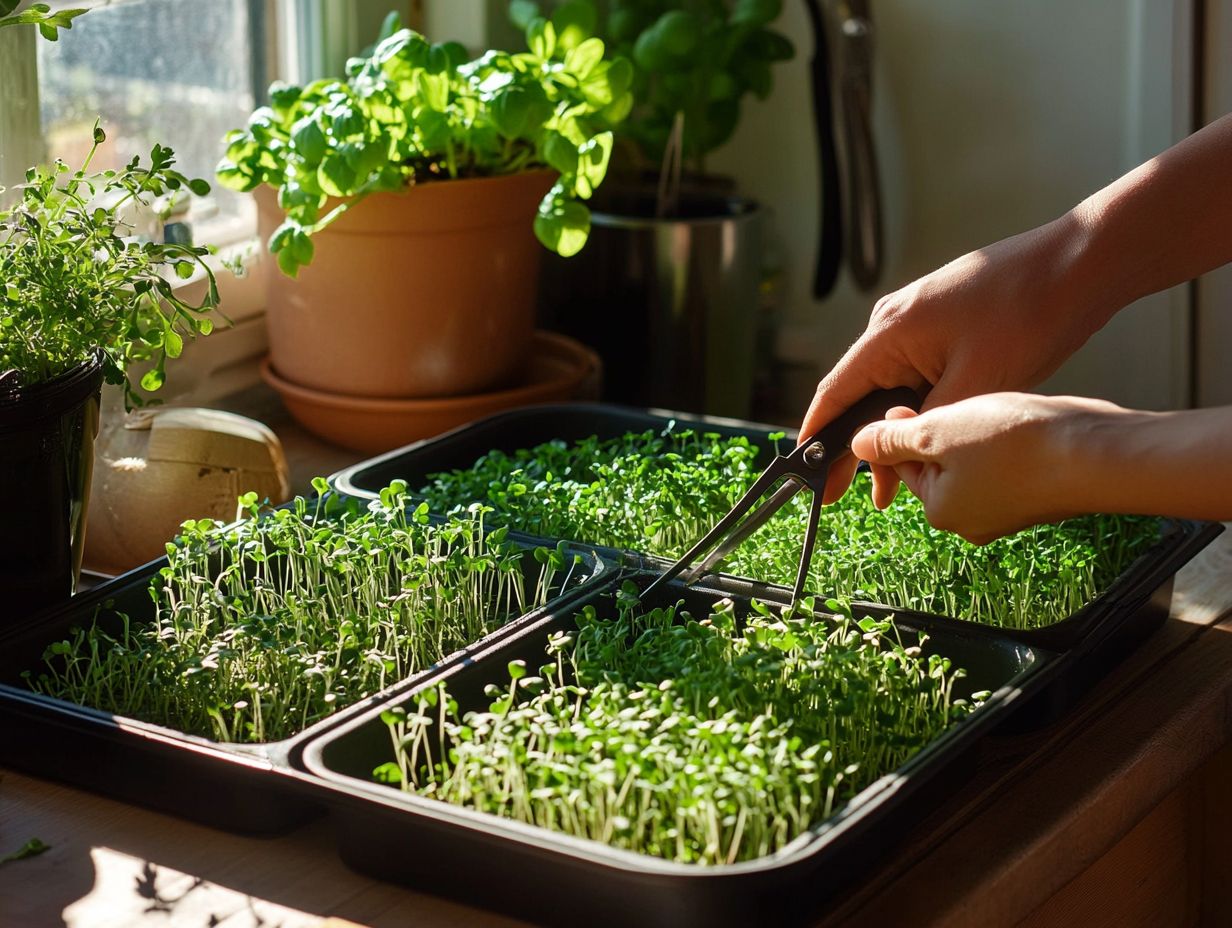
Several factors can significantly influence the harvesting time of your microgreens, including soil conditions, temperature, and watering practices. Each of these elements plays a crucial role in determining their growth rate and overall health.
High-quality soil rich in organic matter provides vital nutrients and ensures proper aeration, promoting healthy root development. Most microgreens thrive between 60 and 75 degrees Fahrenheit. Straying from this range can slow growth or stunt it. To maximize your harvest, consider following guidelines on how to harvest popular microgreen varieties.
Consistent moisture levels are equally important. Proper watering practices are vital overwatering leads to root rot, while underwatering stresses the plants, adversely affecting their flavor profile. By closely monitoring these factors, you can optimize your microgreens for both size and taste. Additionally, learning how to properly harvest microgreens for maximum flavor will help you create a truly exceptional harvest.
How to Harvest Microgreens
Don t miss out on the best flavor and nutrients harvest your microgreens as soon as the true leaves appear! Properly harvesting microgreens is crucial for preserving their freshness and flavor while also fostering the potential for regrowth.
The ideal method entails using clean scissors to snip them just above the soil line. This method keeps your seedlings safe and encourages healthy growth.
By mastering these techniques, you can ensure that your microgreens are not only delicious but also maintain their vibrant appearance. For more information, check out understanding the timing of microgreen harvest.
Step-by-Step Guide
Follow this step-by-step guide to effectively harvest your microgreens while preserving their quality and nutritional value. Start by gathering essential tools like clean scissors and ensure your microgreens are ready for harvest, ideally when they are about 1-3 inches in height with their first true leaves visible.
Before you cut, inspect the microgreens for any signs of pests or diseases, as these can impact their quality significantly. When it’s time to start cutting, make clean, precise cuts just above the soil line, being careful not to damage the roots; this is especially important if you plan to re-harvest. To learn more about enhancing your yields, check out our guide on how to maximize yields from microgreens.
Using a sharp pair of scissors or a knife minimizes bruising, ensuring your greens look their best. After harvesting, gently rinse the greens in cold water to remove any lingering soil particles, then pat them dry with a clean paper towel.
This careful post-harvest care will help maximize their freshness and nutritional benefits. Finally, store your microgreens using harvesting techniques for different microgreens in a breathable container in the refrigerator to keep them crisp and ready for your next culinary adventure.
Storage and Preservation of Microgreens
Proper storage techniques are essential for extending the shelf life and freshness of your harvested microgreens, ensuring their unique flavors and nutrients stay intact. To maximize their longevity, store microgreens in a cool environment, ideally in airtight containers or wrapped in damp paper towels.
This approach helps maintain their texture and nutritional quality for longer, allowing you to enjoy their benefits even more.
Now that you know how to harvest and store microgreens, put your skills to the test and enjoy a fresh salad today!
Best Practices for Maintaining Freshness
To keep your microgreens as fresh as possible, it s essential to adopt best practices in storage and handling. This ensures they maintain their exquisite flavor and nutritional benefits for an extended period. Utilize proper containers, minimize exposure to air, and maintain optimal temperatures. These steps work in harmony to prevent wilting and spoilage.
Temperature management is crucial. Ideally, your microgreens should be stored in a refrigerator set to around 32-34 F to extend their shelf life. Choosing the right container is just as important. Breathable clamshells or perforated bags, which have small holes that allow air to flow, create an ideal environment by allowing moisture to escape while safeguarding the microgreens from external contaminants. For optimal growth, it’s also helpful to understand microgreen harvest timing.
Handle them gently avoid crushing the leaves and only wash them when absolutely necessary. This way, you ll preserve their crispiness and nutrients. By following these guidelines, you can truly maximize your enjoyment of these vibrant and healthful gems.
Common Mistakes in Harvesting Microgreens
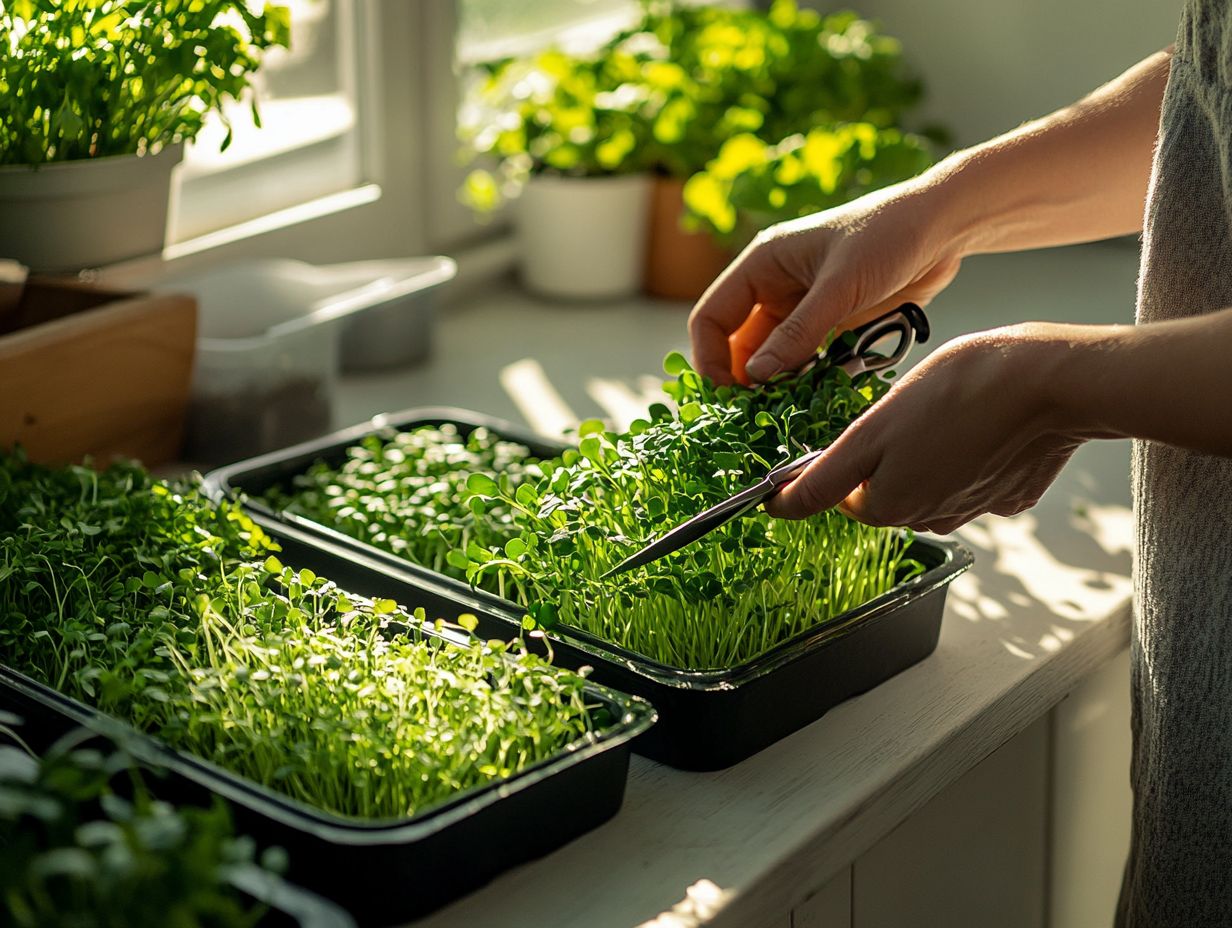
Avoiding common mistakes can enhance your crop’s quality and yield, ensuring you savor the finest flavor and freshness of your microgreens. Proper care and attention to these growing techniques are essential.
Many novice growers tend to overlook crucial aspects like timing, cutting techniques, and post-harvest care. These oversights can result in reduced quality and nutritional value. Understanding the various varieties of microgreens and their specific nutrients, as well as the perfect light conditions for microgreens, will enhance your results. Prioritizing these elements will elevate your harvest to new heights.
How to Avoid and Correct Mistakes
To avoid and rectify mistakes when harvesting microgreens, it s essential to recognize the key factors that can lead to less-than-ideal results, such as improper cutting techniques and insufficient post-harvest care. By grasping these elements, you can ensure a successful harvest while preserving the flavor, freshness, and nutritional value of your microgreens. Recognizing the appearance of healthy seedlings is critical.
One of the smartest strategies you can employ is to wield sharp, sanitized scissors or knives for cutting, as this minimizes damage to those delicate stems. Timing your harvest right just before seedlings develop their first true leaves and begin to flower can significantly enhance the taste and prolong shelf life. For those looking to grow microgreens effectively, refer to this step-by-step guide to sowing microgreens.
After the harvest, handle your microgreens with care and store them in a cool, dry environment. Make it a habit to regularly check humidity levels and opt for breathable packaging to prevent moisture buildup, a common pitfall many encounter. For optimal results, consider timing your microgreens correctly. Proper cleaning and storing techniques will help maintain their freshness. By following these best practices, you can dramatically reduce errors and enjoy a bountiful yield of high-quality microgreens.
Frequently Asked Questions
When is the right time to harvest microgreens?
When is the right time to harvest microgreens?
The right time to harvest microgreens is typically when they have reached a height of 1-2 inches. They should also have developed their first true leaves.
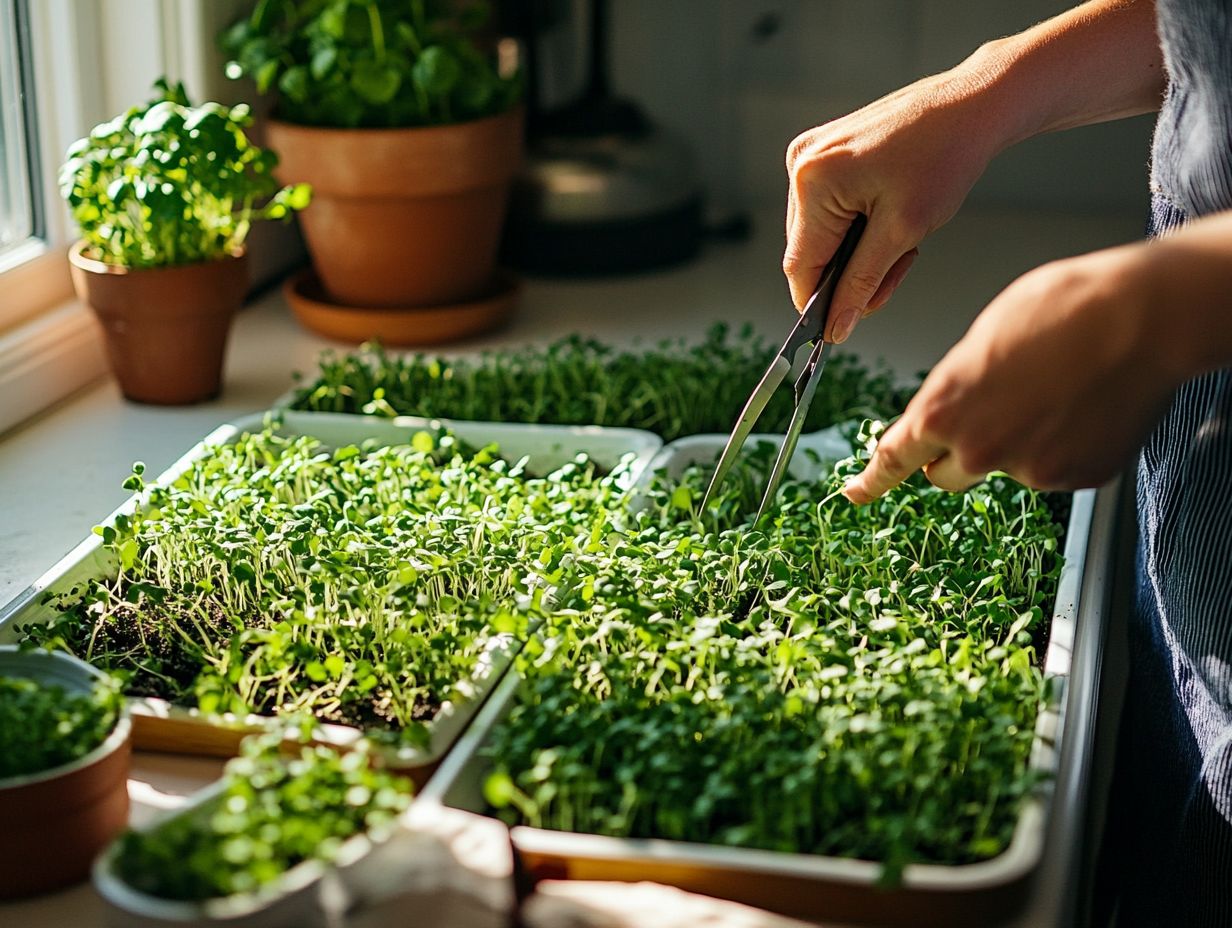
How do I determine if my microgreens are ready to be harvested?
You can determine if your microgreens are ready to be harvested by gently tugging on a few stems. If they resist being pulled out of the soil, it s a sign they are ready.
Observing the stages of growth is important.
What happens if I wait too long to harvest my microgreens?
Waiting too long to harvest can make your microgreens tough and bitter. They lose their delicious taste and health benefits.
Can I harvest my microgreens more than once?
Some varieties of microgreens can be harvested more than once, especially those with a longer growth cycle. It’s best to research the specific variety you are growing to determine if it can be harvested multiple times.
Understanding germination times and methods is also beneficial.
Should I harvest my microgreens in the morning or evening?
Harvesting microgreens in the morning is your best bet! They re most hydrated then, ensuring maximum freshness and flavor.
What is the best way to harvest microgreens?
The best way to harvest microgreens is to use a clean pair of scissors or a sharp knife. Cut the stems just above the soil line to avoid damaging the roots and affecting future growth.
Following proper trimming techniques is essential.

